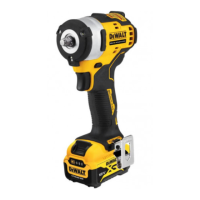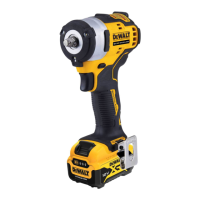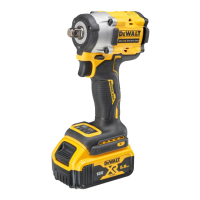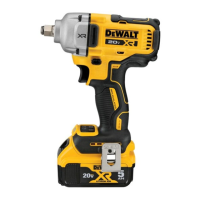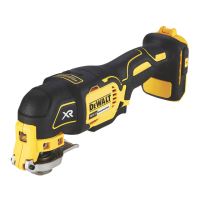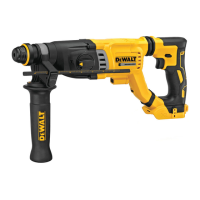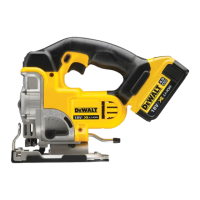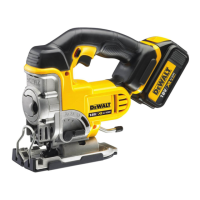10
English
When set in reverse, the tool will impact at a normal speed and
rate of 2200IPM. Upon sensing that the fastener has broken
free, the tool will cease to impact and will reduce speed to help
prevent “run‑off” of loosehardware.
Specifications
Mode Application RPM
Low Mode Normal Impacting 0–650 forward
0–2300 reverse
Medium Mode Medium Impacting 0-1040 forward
0–2300 reverse
High Mode High Speed Impacting 0–2300 forward
0–2300 reverse
Precision Wrench™ Mode Precision Wrench™ 0-820 forward
0–2300 reverse
Anvil (Fig.A, D)
WARNING: Use only impact accessories. Non‑impact
accessories may break and cause a hazardous condition.
Inspect accessories prior to use to ensure that it con tains
nocracks.
CAUTION: Inspect anvils and hog rings prior to use.
Missing or damaged items should be replaced beforeuse.
Place the switch in the locked off (centre) position or remove
battery pack before changingaccessories.
To install an accessory on the hog ring anvil, firmly push
accessory onto the anvil
3
. The hog ring
12
compresses to
allow the accessory to slide on. After accessory is installed, the
hog ring applies pressure to help provide accessoryretention.
To remove an accessory, grasp the accessory and firmly pull
itoff.
OPERATION
Instructions for Use
WARNING: Always observe the safety instructions and
applicableregulations.
WARNING: To reduce the risk of serious
personal injury, turn tool off and disconnect
battery pack before making any adjustments or
removing/installing attachments or accessories.
An accidental start‑up can causeinjury.
Proper Hand Position (Fig.E)
WARNING: To reduce the risk of serious personal injury,
ALWAYS use proper hand position asshown.
WARNING: To reduce the risk of serious personal
injury, ALWAYS hold securely in anticipation of a
suddenreaction.
Proper hand position requires one hand on the main handle
8
.
Usage (Fig.A)
CAUTION: Ensure fastener and/or system will withstand
the level of torque generated by the tool. Excessive torque
may cause breakage and possible personalinjury.
charge in the battery is below the usable limit, the fuel gauge
will not illuminate and the battery will need to berecharged.
NOTE: The fuel gauge is only an indication of the charge left
on the battery pack. It does not indicate tool functionality and is
subject to variation based on product components, temperature
and end‑userapplication.
Variable Speed Trigger Switch (Fig.A)
To turn the tool on, squeeze the trigger switch
1
. To turn the
tool off, release the trigger switch. Your tool is equipped with
a brake. The anvil will stop when the trigger switch is fully
released. The variable speed switch enables you to select the
best speed for a particular application. The more you squeeze
the trigger, the faster the tool will operate. For maximum tool
life, use variable speed only for starting holes orfasteners.
NOTE: Continuous use in variable speed range is not
recommended. It may damage the switch and should
beavoided.
Forward/Reverse Control Button (Fig.A)
A forward/reverse control button
2
determines the direction of
the tool and also serves as a lock‑offbutton.
To select forward rotation, release the trigger switch and depress
the for ward/re verse control button on the right side of thetool.
To select reverse, release the trigger switch and depress the
forward/reverse control button on the left side of thetool.
The centre position of the control button locks the tool in the off
position. When changing the position of the control button, be
sure the trigger isreleased.
NOTE: The first time the tool is run after changing the direction
of rotation, you may hear a click on start up. This is normal and
does not indicate aproblem.
Worklight (Fig.A, C)
The worklight
6
is activated when the variable speed trigger
1
)
is depressed. Pressing the worklight switch
9
)
repeatedly will
cycle through low illumination, high illumination, andoff.
NOTE: The worklight is for lighting the immediate work surface
and is not intended to be used as aflashlight.
Mode Selector (Fig.A, C)
Your tool is equipped with a mode selector
(
7
which allows you
to select one of three speeds or Precision Wrench™ mode. Select
the mode based on the maximum speed/torque needed and
control the speed of the tool using the variable speed trigger
switch
1
.
Precision Wrench™ (Fig.C)
In addition to low speed impacting modes, this tool features
the Precision Wrench™ mode which grants the user greater
control in both fastening and loosening applications. When set
in forward, the tool will fasten at 820RPM until impact begins.
The tool will then pause for 0.75 seconds before continuing
to impact at a rate of 2200IPM, providing the user with
greater control and reducing the chance of overtightening or
damagingmaterial.
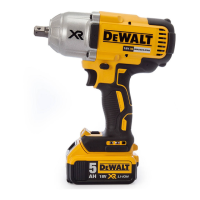
